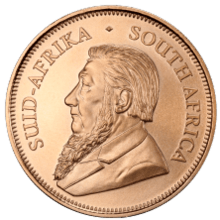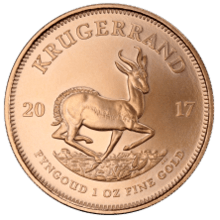Krugerrand
| South Africa | |
| Value | 1 troy oz. fine gold |
|---|---|
| Mass | 33.93 g (1.09 troy oz) |
| Diameter | 32.77 mm (1.28 in) |
| Thickness | 2.84 mm (0.11 in) |
| Composition | Gold (91.67% Au, 8.33% Cu) |
| Years of minting | 1967 – present |
| Obverse | |
 | |
| Design | 1984 by Otto Schultz - Profile of Paul Kruger with "SUID-AFRIKA·SOUTH AFRICA" in the legend. |
| Reverse | |
 | |
| Design | 1984 by Coert Steynberg - A springbok antelope with the mint date in the field. The legend is inscribed with "KRUGERRAND" and the gold weight. |
The Krugerrand (/ˈkruːɡərænd,
Production levels of Krugerrands have significantly varied during the last 50 years. From 1967 to 1969, around 40,000 coins were minted each year. In 1970, the number rose to over 200,000 coins. More than one million coins were produced in 1974, and in 1978 a total of six million Krugerrands were produced. Following the end of apartheid, the production dropped to 23,277 coins in 1998 and since then levels have increased again, albeit not reaching pre-international sanction levels.
History
The Krugerrand was introduced in 1967 as a vehicle for private ownership of gold. It was minted in a copper-gold alloy more durable than pure gold. Economic sanctions against South Africa for its policy of apartheid made the Krugerrand an illegal import in many Western countries during the 1970s and 1980s. These sanctions ended when South Africa abandoned apartheid in 1991.[3][4][5]
By 1980 the Krugerrand accounted for 90% of the global gold coin market.[6] That year South Africa introduced three smaller coins with a half troy ounce, quarter ounce, and tenth ounce of gold.[7]
Over 50 million ounces of gold Krugerrand coins have been sold since production started in 1967.[8]
Variations and imitations
During the great bull market in gold of the 1970s, the gold Krugerrand quickly became the No.1 choice for investors worldwide wanting to buy gold.[9] Between 1974 and 1985, it is estimated that 22 million gold Krugerrand coins were imported into the United States alone.
This huge success of the Krugerrand encouraged other gold-producing countries to mint and issue gold bullion coins of their own, including the Canadian Gold Maple Leaf in 1979, the Australian Nugget in 1981, the Chinese Gold Panda in 1982, the American Gold Eagle in 1986, and the British Britannia coin in 1987.
Private mints have also attempted minting gold and silver bullion rounds (the term coin denotes legal currency) in the style of the Krugerrand. The rounds often depict Paul Kruger and a springbok antelope, some even blatantly copying the design of the Krugerrands themselves, though the inscriptions are altered. These bullion rounds are not offered by the South African Mint or the Government of South Africa, and are therefore not official, have no legal tender value and cannot technically be considered coins.
Properties
The Krugerrand is 32.77 mm in diameter and 2.84 mm thick. The Krugerrand's actual weight is 1 1⁄11 troy ounces (33.93 g). It is minted from gold alloy that is 91.67% pure (22 karats), so the coin contains one troy ounce (31.1035 g) of gold. The remaining 8.33% of the coin's weight of 1⁄11 ozt (2.828 g) is copper (an alloy known historically as crown gold which has long been used for British gold sovereigns), which gives the Krugerrand a more orange appearance than silver-alloyed gold coins. Copper alloy coins are harder and more durable, so they can resist scratches and dents.
The coin is so named because the obverse, designed by Otto Schultz,[10] bears the face of Boer statesman Paul Kruger, four-term president of the old South African Republic. The reverse depicts a springbok, one of the national symbols of South Africa. The image was designed by Coert Steynberg, and was previously used on the reverse of the earlier South African five shilling coin. The name "South Africa" and the gold content are inscribed in both Afrikaans and English (as can be seen on the pictures of the coin).
Since September 1980, Krugerrands have also become available in three additional sizes containing 1⁄2 ozt (15.55 g), 1⁄4 ozt (7.78 g) and 1⁄10 ozt (3.11 g) of pure gold. The word "Krugerrand" is a registered trademark owned by Rand Refinery Limited, of Germiston.[11]
| Denomination | Diameter* (mm) |
Thickness* (mm) |
Weight (g) |
Fineness | Gold content | Edge reeded | |
|---|---|---|---|---|---|---|---|
| (g) | (oz t) | ||||||
| 1 oz | 32.77 | 2.84 | 33.930 | 22 karat 91.67% | 31.103 | 1.000 | 160** |
| 1/2 oz | 27.07 | 2.215 | 16.965 | 22 karat 91.67% | 15.552 | 0.500 | 185 |
| 1/4 oz | 22.06 | 1.888 | 8.482 | 22 karat 91.67% | 7.776 | 0.250 | 150 |
| 1/10 oz | 16.55 | 1.35 | 3.393 | 22 karat 91.67% | 3.110 | 0.100 | 115 |
| * Maximum dimensions | |||||||
Proof Krugerrands
The South African Mint Company produces limited edition proof Krugerrands intended to be collectors' items rather than bullion investments. These coins are priced above bullion value, although non-proof Krugerrands also have a premium above gold bullion value. They can be distinguished from the bullion Krugerrands by the number of serrations on the edge of the coin. Proof coins have 220 while bullion coins have 160.[12][13]
50th Anniversary Krugerrands
2017 marks the 50th year of issuance and to commemorate the anniversary, the South African Mint plans to produce "Premium Uncirculated" versions in gold, platinum, and silver.[8]
Export Control
The South African Reserve Bank restricts the exportation of the Krugerrands by a South African resident to a non-resident to a maximum of R30,000 (about US$2,100 or 1,870 Euro as of June 2018). Visitors to South Africa can export up to 15 coins by declaring the items to the South African Revenue Service.[14]
Charitable donations
Depositing Krugerrands in Salvation Army donation kettles has become an annual tradition of one or more anonymous benefactors in several cities around the United States, including Daphne, AL, Atlanta, GA, Seattle, WA, Spokane, WA, Fargo, ND, Bay City, MI, St. Clair Shores, MI, Kokomo, IN, and Tulsa, OK.[15][16][17]
References
- ↑ "Krugerrand - definition". Dictionary.com, LLC. Retrieved 11 August 2012.
- ↑ Bob Secter (02 Oct 1985) Reagan Bans Imports of S. Africa Krugerrand, The Los Angeles Times, accessed 28 June 2018
- ↑ Yearbook of the United Nations (Volume 45 ed.). United Nations. 1991. p. 114. OCLC 1768016.
- ↑ Yearbook of the United Nations, Volume 45, p. 114, at Google Books
- ↑ "Most South African Sanctions Lifted: ML&B White Paper - Morgan Lewis" (PDF). www.morganlewis.com. Philadelphia, PA: Morgan, Lewis & Bockius LLP. 1991. p. Page 2. Retrieved 30 July 2011.
- ↑ Tom Bethell (4 February 1980). "Crazy as a Gold Bug". New York. 13 (5). New York Media. p. 34.
- ↑ "2010 Krugerrand Series". www.samint.co.za. South Africa: The South African Mint Company. 2010. Retrieved 30 July 2011.
- 1 2 "Global Interest In Silver Investment Expands As South Africa Adds New Silver Krugerrand". SilverSeek.com. Retrieved 12 November 2016.
- ↑ "Gold Krugerrands: Buying gold coins - 17 August 2007". Bullion Vault. Retrieved 11 August 2012.
- ↑ American Numismatic Association (1997). The Numismatist. 110. American Numismatic Association. p. 765. Retrieved 30 November 2011.
- ↑ Gleason, Stefan (16 April 2015). "Why the Krugerrand Is the King of Gold Bullion Coins". Money Metals. Retrieved 20 April 2018.
- ↑ Gleason, Stefan. "Why the Krugerrand Is the King of Gold Bullion Coins". Money Metals Exchange. Retrieved 27 July 2015.
- ↑ "2008 Krugerrand Series". South African Mint Company. Archived from the original on 10 March 2009. Retrieved 6 June 2009.
- ↑ Financial surveillance and exchange controls FAQ
- ↑ Glenn, Stacia (22 December 2011). "Krugerrand dropped into Salvation Army kettle". The Seattle Times. Retrieved 26 June 2013.
- ↑ "For fifth year in a row, mystery person drops a gold coin in Salvation Army kettle". AP. 13 December 2013. Retrieved 14 December 2013.
- ↑ "Gold Krugerrand appears in a Salvation Army red kettle". WDAY. 20 December 2012. Retrieved 26 June 2013.
External links
| Wikimedia Commons has media related to Krugerrand. |